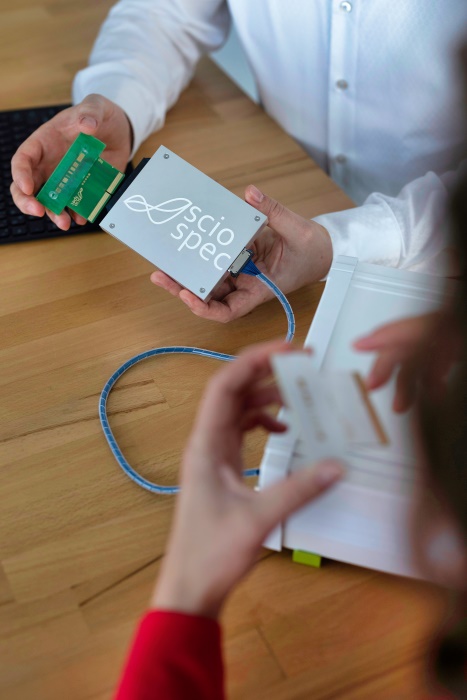

The study “Association of Endogenous PCR Final Product in HPV Human Samples with EBiS Measurements” explores how Electrical Bioimpedance Spectroscopy (EBiS) can help detect DNA in prostate cancer (PCa) samples. Traditional DNA detection methods in prostate cancer research often rely on chemical reagents and visual confirmation steps. This study explores a more efficient, label-free alternative using Electrical Bioimpedance Spectroscopy (EBiS) to detect DNA amplification via electrical signal changes.
This work is closely tied to what we do at Sciospec. The researchers used our ISX-3 impedance analyzer to take precise measurements of DNA samples showing how our technology can be part of easier, faster testing methods in molecular biology.
*Corzo-Cruz, A., Sánchez-Monroy, V., Munguía-Cervantes, J.E., & González-Díaz, C.A. Association of Endogenous PCR Final Product in HPV Human Samples with EBiS Measurements. Computación y Sistemas (2025). https://www.cys.cic.ipn.mx/ojs/index.php/CyS/article/view/5674/3964
Traditional DNA testing often requires complex lab setups, skilled technicians and chemical reagents. This study looked for a simpler way: using impedance spectroscopy to detect whether DNA is present and amplified. Researchers found a clear link between what they saw on a gel (standard method) and what they measured electrically especially at a specific signal frequency.
This matters because it suggests a new path toward label-free, cost-effective diagnostics that are easier to carry out, especially in settings without access to large labs. Prostate tissue, in particular, shows distinct impedance characteristics due to differences in cellular density and membrane composition between healthy, benign, and malignant tissue types. These differences influence how electrical signals travel through the tissue, making impedance a promising tool for detection.
It also shows how Sciospec’s ISX-3 measurement systems can support real-world biomedical research.
🔍Looking for simpler ways to measure complex biological changes? Contact Our team to learn how our solutions can assist your research.


Researchers used the Sciospec ISX-3 impedance analyzer to track electrical changes in DNA samples before and after amplification. These real-time measurements revealed a consistent correlation between impedance shifts and DNA presence demonstrating that the ISX-3 can reliably detect amplified genetic material without requiring dyes, labels, or optical readouts.
What set the ISX-3 apart was its ability to deliver stable, high-resolution data that aligned with standard gel-based methods but without the complexity. The system’s plug-and-play integration and measurement clarity make it a natural fit for research workflows in molecular diagnostics.
👉 Curious how impedance analysis supports DNA-based oncology research? Explore related applications using the ISX-3.
In this study, the ISX-3 impedance analyzer proved instrumental in enabling label-free gene detection by measuring electrical changes before and after DNA amplification without requiring dyes, fluorescence, or optical readers. The ISX-3 offered the precision and flexibility researchers needed to track small but significant changes in electrical properties that correlate with DNA presence. This approach simplifies molecular workflows by eliminating complex lab procedures and consumables, making electrical DNA detection both cost-efficient and scalable
Key advantages of the ISX-3 for DNA-based diagnostics:
Allows fine-tuned impedance analysis of amplified genetic material capturing both bulk solution effects and subtle electrode sample interactions.
Detects minor impedance shifts linked to DNA strand presence, concentration, or conformation critical for early-stage genetic analysis and validation.
Easily connects to microfluidic systems, reaction tubes, or multiwell plates supporting PCR workflows, electrophoretic systems, and custom assay chambers.
By enabling real-time, label-free tracking of DNA amplification the ISX-3 supports faster diagnostic development, reduces reagent dependency and enhances reproducibility in genetic and biomedical research.
👉 Looking for impedance tools that simplify molecular workflows? Explore the ISX-3 analyzer and related systems designed for life science applications.


As research moves forward, the need often grows from testing a few samples to working with many. That’s where the ISX-3’s scalable design becomes important. It can be expanded with extra measurement channels to handle multiple samples in sequence, helping researchers cover more ground without slowing down.
This makes it a good choice not only for initial research, but also for teams planning larger studies or broader testing scenarios.
👉 Planning a high-throughput genetic analysis workflow? Learn how ISX-3 multiplexing supports scalable DNA diagnostics.
Medical Research Applications: DNA Analysis with ISX-3
While this study focused on a specific gene related to prostate cancer, the method applies to other medical research areas too. For these fields, our Medical Research ISX-3 offers additional flexibility tailored for biomedical and life science research with optional safety features for regulated lab environments
It supports advanced configurations for teams exploring clinical research, diagnostic markers or health-related studies, while staying adaptable and easy to integrate.
🏥 Evaluate how the Medical Research ISX-3 can accelerate your clinical development pipeline.
🔬 See technical details and clinical use features


Our experts are ready to help you understanding how this technology works and how you can apply and integrate it into your work. Get in touch today to get a personalized consultation to enhance your work with our advanced solutions
Electrical Bioimpedance Spectroscopy (EBiS) measures how biological materials like DNA samples respond to small electrical signals across frequencies. As DNA is amplified via processes like PCR, its electrical characteristics change. EBiS detects these changes, allowing researchers to confirm DNA presence without chemical labels.
In a recent study, EBiS powered by the Sciospec ISX‑3 analyzer , was used to monitor gene amplification in prostate cancer samples.
PCR is a standard method for amplifying DNA, but its detection phase often relies on fluorescent dyes and optical systems. Label-free techniques like EBiS detect amplified DNA through its electrical signature eliminating the need for optical hardware or chemical reagents.
This reduces complexity and cost, making DNA testing more accessible and scalable. Tools like the ISX‑3 deliver accurate, label-free measurements ideal for modern workflows.
👉 Learn how our systems support simpler, more efficient DNA detection workflows.
Different frequencies reveal different aspects of a sample. In impedance-based DNA detection, certain low frequencies—such as 144 Hz in a recent prostate cancer study showed strong correlation with DNA presence. Other studies use ranges from kilohertz to megahertz.
👉The ISX‑3 analyzer offers broad frequency scanning capabilities, allowing researchers to identify the optimal range for their assay type.
Yes. Impedance changes not only confirm the presence of DNA but can also correlate with its concentration. As DNA levels rise, the measured signal such as magnitude or phase angle shifts in quantifiable ways. In prostate cancer research, EBiS measurements aligned closely with PCR results, enabling semi-quantitative DNA analysis. These insights were made possible by the ISX‑3’s high sensitivity and precision.
HPV (Human Papillomavirus) is commonly linked to cervical cancer, but certain high-risk strains have also been found in prostate cancer tissue. Some researchers are exploring whether HPV may contribute to prostate cancer development. EBiS offers a non-invasive method to detect HPV-related genetic markers, and early studies using the ISX‑3 analyzer show promise in this area.
Yes. Unlike traditional detection methods, impedance-based techniques don’t require bulky optics or complex reagents, making them ideal for compact, mobile, or point-of-care systems.The ISX‑3 has been integrated with miniaturized biochips and simplified workflows, showing strong potential for use in clinics, remote diagnostics, or decentralized research.
👉 Get in touch to explore how our systems support portable diagnostics.
This research reinforces how impedance spectroscopy enabled by tools like the ISX-3 can simplify and accelerate molecular diagnostics. As gene-based studies grow, the need for scalable, label-free tools is rising and Sciospec is helping meet that demand. By showing a strong link between DNA amplification and electrical measurements, it opens doors to new testing strategies that don’t rely on traditional lab-intensive procedures.
Sciospec is proud to support work like this. Our goal is to make advanced measurement tools that fit researchers’ needs without adding complexity.
👉 Want to see how our solutions can support your research? Reach out to our applications team to to discuss tailored impedance solutions
💡Curious for more? Check out our latest developments and products.
🧪Want to try it yourself? Contact us for more information
🚀Looking for a tailored solution? Our experts can help!
📢 Follow us on LinkedIn for more updates.
#Innovation #Sciospec #Bioimpedance #HPV #prostate cancer
explore by relevant keywords
…or just browse our most recent posts: